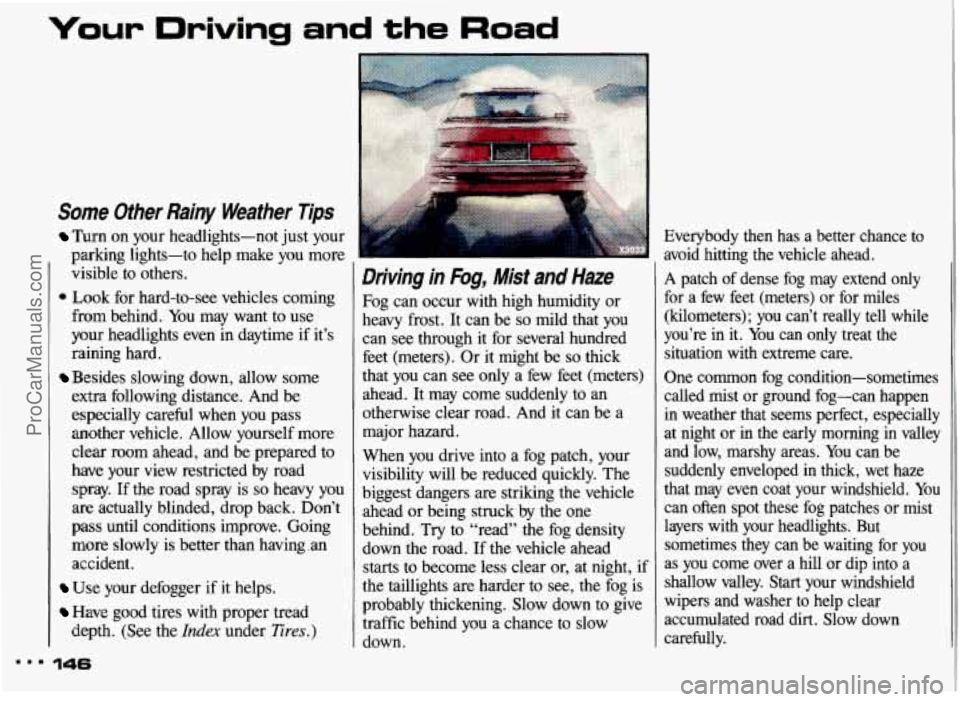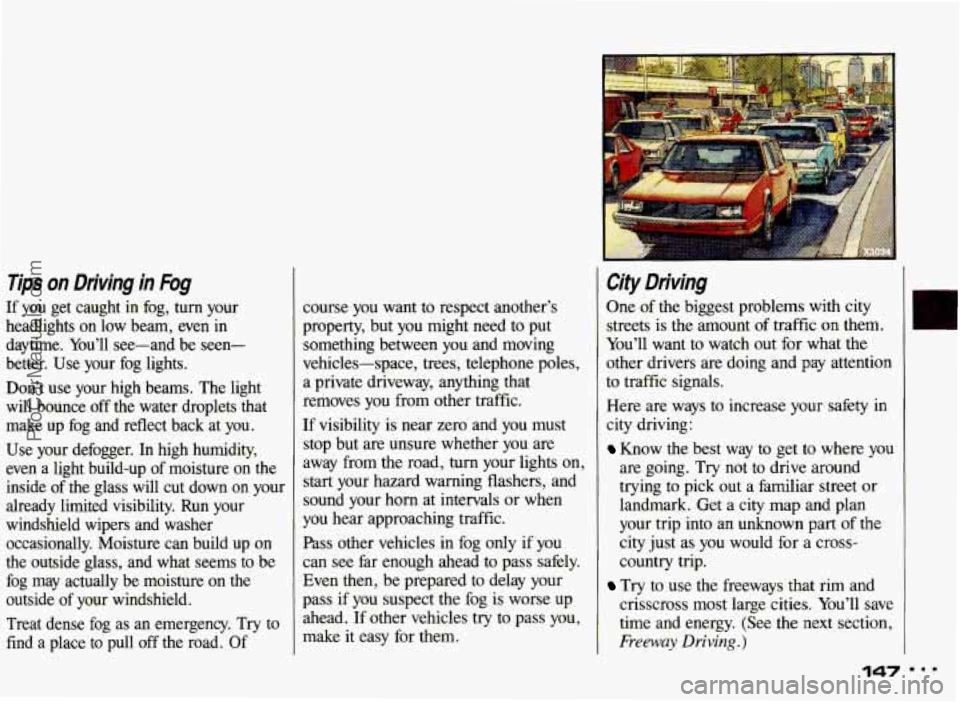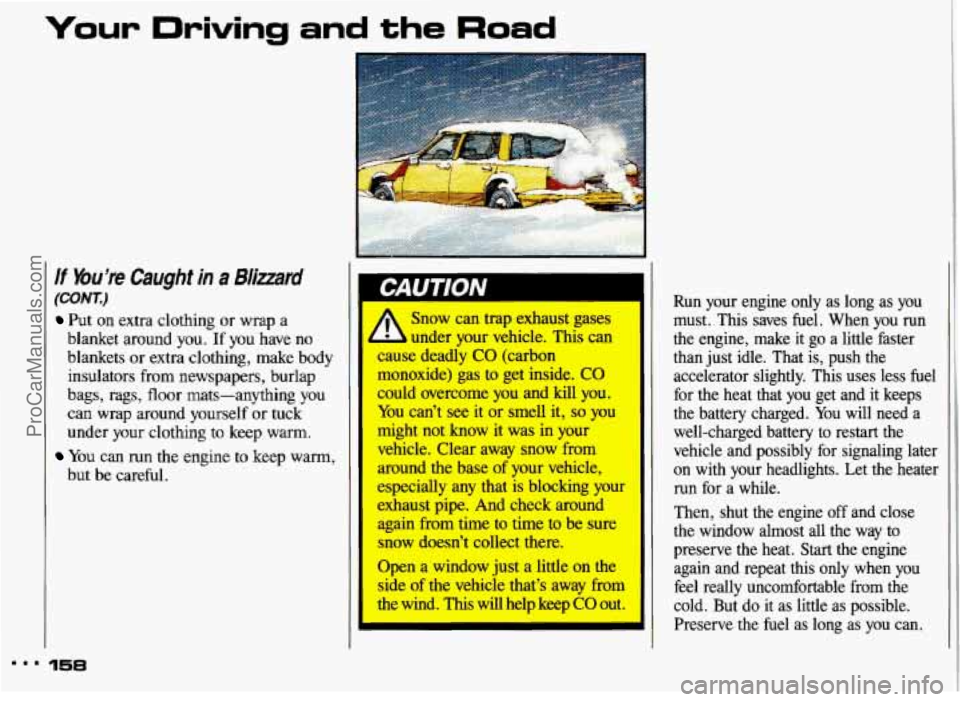1993 PONTIAC GRAND-AM headlights
[x] Cancel search: headlightsPage 147 of 306

Your Driving and the Road
Some Other Rainy Weather Tips
Turn on your headlights-not just your
parking lights-to help make you more
visible to others.
* Look for hard-to-see vehicles coming
from behind. You may want to use
your headlights even in daytime
if it’s
raining hard.
Besides slowing down, allow some
extra following distance. And be
especially careful when you pass
another vehicle. Allow yourself more
clear room ahead, and be prepared
to
have your view restricted by road
spray. If the road spray is
so heavy you
are actually blinded, drop back. Don’t
pass until conditions improve. Going
more slowly is better than having an
accident.
Use your defogger if it helps.
Have good tires with proper tread
depth. (See
the Index under Tires.)
Driving in Fog, Mist and Haze
Fog can occur with high humidity or
heavy frost. It can be
so mild that you
can see through it for several hundred
feet (meters). Or it might be
so thick
that you can see only a few feet (meters)
ahead.
It may come suddenly to an
otherwise clear road. And it can be a
major hazard.
When you drive into a fog patch, your
visibility will be reduced quickly. The
biggest dangers are striking the vehicle
ahead or being struck by the one
behind.
Try to “read’’ the fog density
down the road. If the vehicle ahead
starts
to become less clear or, at night, if
the taillights are harder to see, the fog is
probably thickening. Slow down to give
traffic behind you a chance to slow
down. Everybody then has a better chance
to
avoid hitting the vehicle ahead.
A patch of dense fog may extend only
for a few feet (meters)
or for miles
(kilometers); you can’t really tell while
you’re
in it. You can only treat the
situation with extreme care.
One common fog condition-sometimes called mist or ground fog-can happen
in weather that seems perfect, especially
at night or in the early morning
in valley
and low, marshy areas. You can be
suddenly enveloped in thick, wet haze
that may even coat your windshield. You
can often spot these fog patches or mist
layers with your headlights.
But
sometimes they can be waiting for you
as you come over a hill or dip into a
shallow valley. Start your windshield
wipers and washer to help clear
accumulated road dirt. Slow down
carefully.
... 146
ProCarManuals.com
Page 148 of 306

Tips on Driving in Fbg
If you get caught in fog, turn your
headlights on low beam, even in
daytime, You’ll see-and be seen-
better. Use your fog lights.
Don’t use your high beams. The light
will bounce
off the water droplets that
make up fog and reflect back at you.
Use your defogger.
In high humidity,
even a light build-up of moisture
on the
inside of the glass will cut down
on your
already limited visibility.
Run your
windshield wipers and washer occasionally. Moisture can build up on
the outside glass, and what seems to be fog may actually be moisture on the
outside of your windshield.
Treat dense fog as
an emergency. Try to
find a place to pull off the road. Of course
you want to respect another’s
property, but you might need to put something between you and moving
vehicles-space, trees, telephone poles,
a private driveway, anything that
removes you from other traffic.
If visibility is near zero and you must
stop but are unsure whether you are
away from the road,
turn your lights on,
start your hazard warning flashers, and
sound your horn at intervals or when
you hear approaching traffic.
Pass other vehicles in fog only if you
can see far enough ahead to pass safely.
Even then, be prepared to delay your
pass if you suspect the fog is worse
up
ahead. If other vehicles try to pass you,
make it easy for them.
City Driving
One of the biggest problems with city
streets is the amount of traffic on them.
You’ll want to watch out for what the
other drivers are doing and pay attention
to traffic signals.
Here are ways to increase your safety in
city driving:
Know the best way to get to where you
are going. Try not to drive around
trying to pick out a familiar street or
landmark. Get a city map and plan
your trip into
an unknown part of the
city just as you would for
a cross-
country trip.
Try to use the freeways that rim and
crisscross most large cities. You’ll save
time and energy. (See the next section,
Freeway Driving.
147
... . -
ProCarManuals.com
Page 159 of 306

lf bu’re Caught in a Bliuard
(CONZ)
Put on extra clothing or wrap a
blanket around you.
If you have no
blankets or extra clothing, make body
insulators from newspapers, burlap
bags, rags, floor mats-anything you
can wrap around yourself or tuck
under your clothing to keep warm.
You can run the engine to keep warm,
but be careful.
158
cause deadly CO (carbon
monoxide) gas to get inside.
CO
could overcome you and kill you.
You can’t see it or smell it,
so you
might not know it was
in your
vehicle. Clear away snow from
around the base of your vehicle,
especially any that
is blocking your
exhaust pipe. And check around
again from time to time to be sure
snow doesn’t collect there.
Open a window just a little on the
side
of the vehicle that’s away from
the wind.
This will help keep CO out. Run your engine only as long as you
must. This saves fuel. When you
run
the engine, make it go
a little faster
than just idle. That is, push the
accelerator slightly. This uses less fuel
for the heat that you get and it keeps
the battery charged. You will need a
well-charged battery to restart the
vehicle and possibly for signaling later
on with your headlights.
Let the heater
run for a while.
Then, shut the engine off and close
the window almost all the way to
preserve the heat.
Start the engine
again and repeat this only when you
feel really uncomfortable from the
cold. But do it as little as possible.
Preserve the fuel as long as you can.
ProCarManuals.com
Page 250 of 306

Fuse Rating Circuitry
Fuse Usage
HORN
ALARM
HTR-A/C
RDO IGN
TURN
DR LK
TAIL LPS
WDO
WIPER ERLS
FTP
ACC
IGN ECM
HDLP
15
15
25
10
20
20
20
30
25
15
20
30
20
20
Back Up Lights, Electronic PRNDL (automatic transaxle)
Fuel Pump, Fuel Injectors
Turn/Hazard/Stop Lights, Anti-Lock Brakes
(ABS), Brake-
Transaxle Shift Interlock
(BTSI)
Power Door Locks, Power Mirrors, Cigar Lighter
BLANK
Instrument Panel Lights
Rear Window Defogger Relay, Chime, Gages,
ABS , BTSI,
Daytime
Running Lights (Dm) (Canada)
Horn
Chime, Interior Lights, Passive Restraints, Radio/Clock Memory
Heater, Air Conditioning, ABS, DRL (Canada), Engine Block
Heater
Radio, Cruise Control, Variable
Effort Steering
Turn Signals
Power Door Locks
Exterior Lights, Fog Lights, Instrument Panel Lights, DRL
(Canada)
Power Windows (Circuit Breaker)
Windshield WipedWasher
Engine Controls, Starter and Charging System
BLANK
Flash-to-Pass
(US.)
Power Seats, Rear Window Defogger (Circuit Breaker)
BLANK
Engine Control Module, Ignition System
BLANK
Headlights, DRL (Canada) (Circuit Breaker)
ProCarManuals.com
Page 255 of 306

Service & Appearance Care
Replacement Bulbs
OUTSIDE LIGHTS
Back Up Lights .......................................
Front Parking/Turn Signal Lights .........................
License Plate Light ....................................
Center High-Mounted Stoplight ...........................
Halogen Headlights Low Beam
..... ................ .........
HighBe am .........................................
Front ..............................................
Rear ..............................................
TrunkLight ..........................................
FogLights ...........................................
Side Marker Lights
Stop/Tail/Turn Signal Lights
.............................
BULB
2057
2057
NA
194
912
9006
9005
194 NA
24
3057
562
9442876
mmm 254
ProCarManuals.com
Page 298 of 306

Headlights ..................... 74
High-Low Beam Changer
....... -76
Instrument Panel
Intensity Control
............. 76
“On” Reminder
............... 75
Replacement Bulb
............ 228
Wiring
..................... 250
Heater (see
Comfort Controls)
Heater, Engine Block ........ .56. 213
High Beams
............... .76. 143
Highway Hypnosis
.............. 151
Hill and Mountain Roads
......... 152
Hood Release
.................. 205
Safety Warning
............... 206
Warning, Overheated
Engine
.................... 92
Horn
......................... 67
Hot Engine. Safety Warnings . .179. 206
How the Anti-Lock Brake
System Works
................ 132
Hydraulic Clutch
.......... .220. 253
Hydroplaning
.................. 145
Hills. Parking on
.......... .154. 165
Identification Number. Vehicle
.... 247
Idling Your Engine
.......... .64. 67
Ignition
Key
......................... 44
Key Release Button
............. 51
Positions
..................... 51
Illuminated Entry/Exit System
...... 46
Indicator Lights
Infant Restraint
Inflation. Tires
....... .232. 252. 304
Inside Rearview Mirror
........... 81
Inspections. Owner
.............. 271
Instrument Panel
................ 86
Instrument Panel Warning Lights .... 91
(see Warning Lights)
(see Child Restraints)
.................... J ack. Tire 187
Jump Starting
.................. 171
Key Release Button
.............. 51
Keys
.......................... 44 Lane
Change Indicator
........... 69
Lap-Shoulder Safety Belt .......... 18
Front
........................ 18
Rear ........................ 23
Use by Children
........... .27, 36
Latches. Seatback ................ 11
Lighter ........................ 85
Lights
Charging System
.............. 95
Check Gauges ................ 99
Daytime Running Lights ......... 75
Fog Lights .............. .77. 229
Headlights
.......... .74. 228. 254
Headlights Reminder
........... 75
Instrument Panel Intensity Control
. . 76
Parking ................. .74. 254
Reading
................ .77. 255
Removing
& Replacing
Bulbs
............ .228. 229. 254
Replacement Bulbs
............ 254
Shift
........................ 62
Taillights
............... .229. 254
Trunk ....................... 78
Turn Signal ............. .69. 254
Warning Lights
........... .91. 170
Lights on Reminder .............. 75
Loading Your Vehicle ............ 230
297 ’ ’
ProCarManuals.com